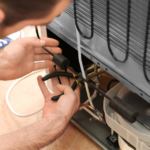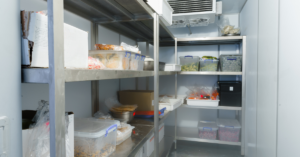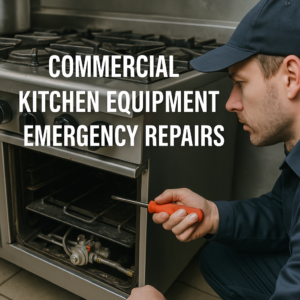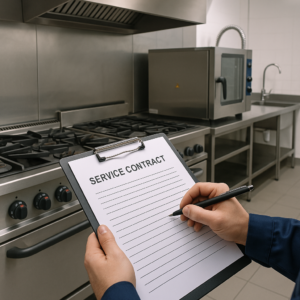
Nobody walks into a kitchen and marvels at the fryer gunk or the layers of grease on the exhaust hood. Clean kitchens don’t just look good—they perform better. The secret? Smart, consistent cleaning routines that keep your commercial kitchen equipment alive longer and working like it’s fresh out the box.
This isn’t about wiping surfaces with a rag and calling it a day. It’s about precision. A dirty commercial kitchen doesn’t just risk health codes or inspections—it chews through equipment life faster than a poorly trained line cook during dinner rush.
Why This Matters: The Hidden Cost of Neglect
Commercial kitchen gear is expensive. A single malfunctioning range, fryer, or walk-in fridge can bring operations to a screeching halt. Worst-case? A failed inspection, food spoilage, or worse—a fire. According to the National Fire Protection Association, nearly 60% of restaurant fires start in the kitchen, often due to built-up grease in hoods, vents, and cooking appliances. That’s avoidable.
And then there’s efficiency. A clogged condenser coil or dirty burner means the unit works harder—eats more energy, and breaks faster. So what’s the fix? Clean smarter. Clean often. And know where to look.
1. Deep Clean Daily, But Know Your Targets
Daily cleaning shouldn’t just be a checklist—it should be strategic.
-
Wipe down flat tops and griddles after every shift; use the right scraper so you’re not gouging the metal.
-
Empty and wipe the deep fryer; filter the oil, and clean the baskets.
-
Steam tables? Drain and descale.
-
Under-counter fridges? Clean gaskets and wipe interiors—yes, every day.
It’s not obsessive—it’s insurance.
2. Weekly = Time for the Grit Work
Every week, hit the stuff that doesn’t look dirty but is.
-
Clean condenser coils on refrigeration units with a coil brush or vacuum—this one step adds years to a unit’s life.
-
Degrease exhaust hoods and filters—if you’re not pulling those filters and soaking them, you’re risking fire and airflow issues.
-
Sharpen blades on slicers and clean between every hidden seam.
-
Check and clean the drip trays on ice machines and drink dispensers.
Weekly jobs are the backbone of equipment preservation. You miss a week, and it shows.
3. Don’t Forget the Vents, Floors, and Walls
Grease splatter loves corners. Vents suck up nastiness. Floors trap particles that grind underfoot and turn your kitchen into a skating rink.
-
Power scrub the floors weekly. Use degreaser—not just soap and water.
-
Clean walls and ceiling vents that pull in airborne oil. You’d be surprised how fast buildup happens, especially above fryers and ovens.
-
Use a long-handle brush to dust and degrease air return ducts and filters.
4. Watch the Water and Steam Equipment
Dishwashers, steamers, and combi ovens build up limescale like it’s their job.
-
Use a proper descaler and clean the interiors monthly.
-
Drain boilers if applicable.
-
Check for leaks around seals—standing water is a mold and rust party waiting to happen.
-
Don’t use hard water without filtration; it’s a silent equipment killer.
5. Schedule Professional Deep Cleans and Servicing
You can’t do it all with elbow grease. At least twice a year, bring in certified pros to do:
-
Full exhaust system cleanings (including ductwork to the roof)
-
Gas line and burner inspections
-
Refrigeration system diagnostics
-
Combustion checks on ovens and steam equipment
And don’t skimp on filter replacements—air, grease, water, you name it.
6. Keep a Cleaning Log—And Stick to It
This is boring but brilliant. A log keeps people accountable, shows inspectors you mean business, and makes it crystal clear what’s been done—and what’s overdue.
Make it digital. Use a whiteboard. Clipboards on fridges. Just keep it visible, and make sure someone’s in charge of enforcement.
7. Use the Right Cleaning Tools for the Job
This isn’t a Windex world. Wrong tools scratch stainless steel, ruin seals, or worse, void warranties. Have a cleaning kit with:
-
Degreaser (food-safe, non-toxic)
-
Stainless steel cleaner
-
Coil brush
-
Scrapers
-
Steam cleaner for grout and corners
-
Food-grade descaler
Train your team how to use each—don’t assume they’ll figure it out.
8. Respect the Manufacturer’s Manual
Yeah, it’s dusty. But that little booklet? It tells you exactly how to clean each unit without wrecking it. It also tells you the service intervals, and what voids your warranty. Read it. Then follow it. Then tape it to the wall if you have to.
A Clean Kitchen Is a Working Kitchen
Equipment doesn’t fail because it’s old. It fails because it’s abused, ignored, and smothered in burnt cheese and fryer grease.
Clean gear runs better. It cooks evenly. It chills faster. It breaks down less. And most importantly, it keeps your kitchen moving when it counts—during the crunch, the rush, and the 15-ticket printer panic.
So if you want to protect your equipment investment, stay ahead of health codes, and sleep better knowing tomorrow’s service will go smooth—clean smarter. Clean consistently. And teach your crew to treat that oven or freezer like it’s worth its weight in truffles.
Because honestly, it is.






